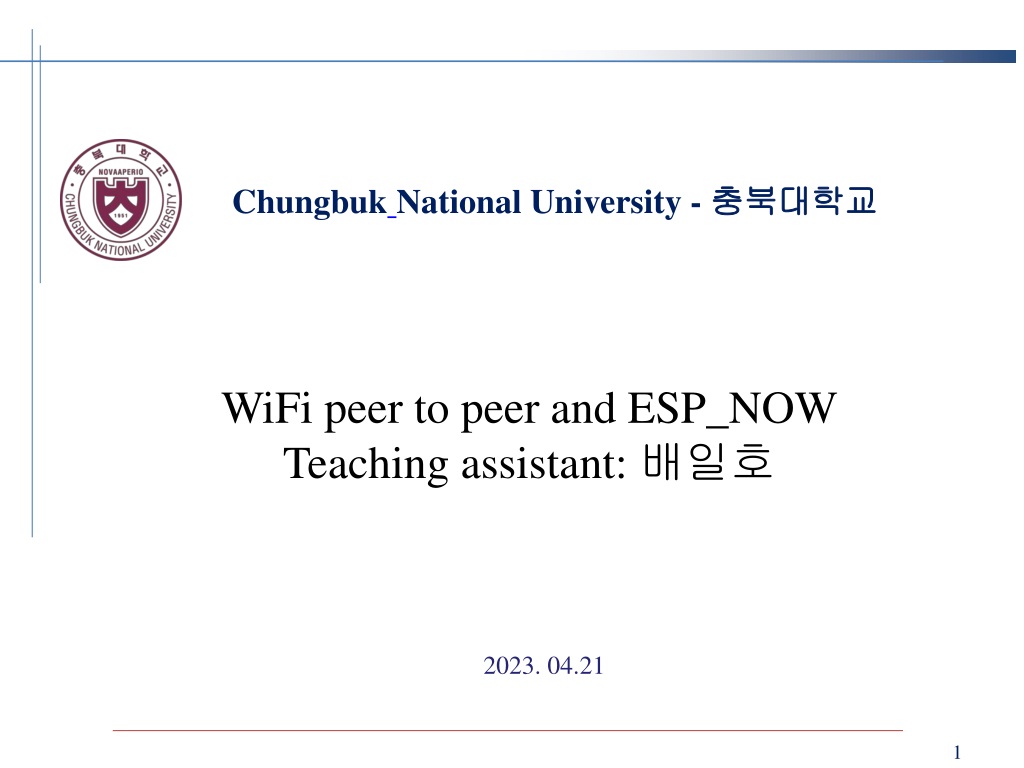

0 likes | 44 Views
This project focuses on implementing WiFi Peer-to-Peer and ESP-NOW protocols for wireless communication between ESP32 and ESP8266 devices. WiFi Peer-to-Peer allows direct device connections without a router, while ESP-NOW enables low-power communication. The hardware, principles of operation, code implementation, and test results are discussed to showcase the project's functionality and benefits in different scenarios.

E N D
Chungbuk National University - 충북대학교 충북대학교 WiFi peer to peer and ESP_NOW Teaching assistant: 배일호 2023. 04.21 1
Contents 1. Block diagram 2. Hardware 3. Principle of operation 4. Code and code description 5. Test results 2
2. Block diagram ESP32 V3 board Block diagram of ESP32S3 3
2. Hardware Description of ESP32 v3 board 4
2. Hardware something to use 5
4. Principle of operation ESP-NOW WiFi Peer-to-Peer and ESP-NOW are two different protocols that can be used for wireless communica tion between devices. WiFi Peer-to-Peer (WiFi Direct) is a standard developed by the WiFi Alliance that allows devices to c onnect to each other without the need for a wireless access point (router). With WiFi P2P, two or more devices can connect directly to each other and communicate using the WiFi radio. ESP-NOW is a protocol developed by Espressif Systems that allows for low-power, low-latency com munication between ESP32 and ESP8266 devices using the 2.4GHz radio. ESP-NOW is designed for scenarios where devices need to communicate with each other directly, without the need for an access point or other infrastructure.. Both WiFi P2P and ESP-NOW can be used for wireless communication between devices, but they hav e different strengths and weaknesses. WiFi P2P is a more versatile protocol that can be used with any WiFi-enabled device, while ESP-NOW is designed specifically for communication between ESP32 an d ESP8266 devices. The choice between WiFi P2P and ESP-NOW depends on the specific requirements of your project. If you need to connect to non-ESP devices or require more versatile networking capabilities, WiFi P2P m ay be the better option. If you are working within the ESP32 or ESP8266 ecosystem and require fast a nd reliable communication between devices, ESP-NOW may be the better choice. 6
3. Principle of operation Download the Arduino IDE Download the Arduino IDE that is compatible with your computer system 7
4. Code and Code description #include <Arduino.h> #include <WiFi.h> #include <esp_wifi.h> #include <QuickEspNow.h> #include "HT_SSD1306Wire.h" #include <stdlib.h> #include <string> This section includes several libraries needed for the progra m to run. • SSD1306Wire display(0x3c, 500000, SDA_OLED, SCL_OL ED, GEOMETRY_128_64, RST_OLED); This line creates an object of the SSD1306Wire cl ass, which is used to control the OLED display. int sCount = 1, numCount = 0; String sDatas[8]; These variables are used to store data received over ESP-NOW. static const String msg = "Hello Device 1"; static uint8_t receiver[] = {0xDE, 0xAD, 0xBE, 0xEF, 0xFE, 0xED}; #define DEST_ADDR receiver const unsigned int SEND_MSG_MSEC = 2000; These variables are used to set up the me ssage that will be sent over ESP-NOW void dataReceived(uint8_t *address, uint8_t *d ata, uint8_t len, signed int rssi, bool broadcast) { ... } This is a callback function that will be called wh enever data is received over ESP-NOW. 8
4. Code and Code description void setup() { display.init(); display.setFont(ArialMT_Plain_10); display.setTextAlignment(TEXT_ALIGN_LEFT); display.drawString(50, 0, "Test"); display.display(); Serial.begin(115200); WiFi.mode(WIFI_MODE_STA); uint8_t mac[] = {0xDE, 0xAD, 0xBE, 0xEF, 0xFE, 0xED}; esp_wifi_set_mac(WIFI_IF_STA, mac); WiFi.disconnect(false, true); quickEspNow.onDataRcvd(dataReceived); quickEspNow.setWiFiBandwidth(WIFI_IF_STA, WIFI_BW_HT20); quickEspNow.begin(1); This function is called once when the program st arts up. It sets up the OLED display and WiFi mo dule, sets the MAC address of the WiFi module, and sets up the ESP-NOW communication. } void loop() { static unsigned int counter = 0; String message = String(msg) + " " + String(counter++); if (!quickEspNow.send(DEST_ADDR, (uint8_t *)message .c_str(), message.length())) { Serial.println(">>>>>>>>>> Message sent"); } else { Serial.println(">>>>>>>>>> Message not sent"); } delay(SEND_MSG_MSEC);} This function is called repeatedly as long as the program is running. It sends a message over ESP-NOW every SEND_MSG_MSEC milliseconds 9
7. Test result If 2 devices are connecte d, data will be sent betwe en the 2 devices. The data will be printed o n the screen as shown in t he figure above. 10
Thank you for your consideration